Tibet – where you can touch the sky… Episode 2
Over 40 km away from Lhasa, capital of Tibet, there is the Ganden Monastery, another jewel of Tibetan architecture, built high up on a hill that is gradually being revealed as one climbs. This monastery is the seat of the Gelugpa order whose leader is the Dalai Lama and this is why it was shelled by the artillery in 1959 and 1965. Here we could find the remains of Tsongkhapa, founder of the Gelugpa order and great reformer of Tibet. In 1965, when the Red Guards conquered and destroyed the monastery, the chörten with the remains of Tsonghapa was broken, and, to the general surprise, his body was perfectly preserved as if he had lived, although he had been dead for 550 years. Despite the miracle, the Red Guards destroyed his body, only a few fragments of the skull being saved by a brave monk. Today, these fragments are resting in Tsongkhapa’s new chörten.
Two other great monasteries are Sakya and Gyantse, which are located much farther away from Lhasa, near Shigatse. If the former is the headquarters of the minority order Sakyapa, the latter has the advantage of being located in the Tibetan city which is less Chinese.
The Tashilhunpo Monastery in the Shigatse city is also worth visiting. Its historical significance is special – it was founded by the first Dalai Lama (the current one is the fourteenth) in 1447, and the fifth Dalai Lama has said the abbot of the great monasteries was a manifestation of Őpagme, the cognitive manifestation of Buddha, calling him Panchen Lama (meaning “great scholar”). Ever since, Shigatse and the Tashilhunpo monastery were the seat of a parallel dynasty of high lamas, of Panchen Lama. Here, the statues of the tenth Panchen Lama – the one who was imprisoned and tortured by the Chinese authorities for 20 years for showing his loyalty to Dalai Lama – are in the centre of worship. The pictures of the fake eleventh Panchen Lama, the son of a party secretary in Lhasa are also present, but I felt like the Tibetan pilgrims sort of rejected them.
The last monastery that I recommend is Rongphu. It does not have too much of a historical significance (it was founded in 1902), it is of a minority order (Nyingmapa), it is quite austere, with poor decoration, but has the advantage of being the monastery situated at the highest altitude in the world – 5050 metres. Situated on the road to Everest Base Camp, it is the last place where you can receive the blessing of the Gods before conquering the great peak. Actually, the image with the monastery and the Everest in the background is one of the most impressive in the world.
Visiting Tibet is an experience, a journey through a history that you believed as long gone. But it is also a way through the present, around a currently occupied country that struggles to maintain its unique and rich cultural identity. And is, indeed, the place where you can touch the sky with your hand .. both physically and spiritually.
How to get to Tibet
By plane – either from Nepal (Kathmandu), or from several cities in China. Personally, I used the Chengdu – Lhasa flight operated by Air China. By train, you can also leave from Chengdu, it takes about 48 hours, the cheapest ticket being 30 euros (per seat), the soft sleeper bunk being about 100 euros. Find more about “ How to get to Tibet
Tibet visa
For Tibet, you need a special permit issued by the Tibet Tourism Bureau. Theoretically, you cannot enter Tibet unless you are part of an organized touristic group I recommend ask Tibet Vista for help, Tibet Vista, Tibet Travel & Tours is a Tibet Travel Guide offers innovative ideas on itineraries,things to do and see,places to eat and sleep and visa guidelines etc.. In fact, this group only meets on the Chengdu airport, they fly together to Lhasa and then each goes in his business. In general, TTB rules (Tibet Tourism Board) are not observed, the authorities closing their eyes to independent travelers. However, rules are suddenly obeyed when incidents occur in Tibet (most of them being anti-Chinese demonstrations). There are certain “sensitive” periods when they do not issue permits to visit Tibet (such as China’s National Day, Dalai Lama’s Birthday, the anniversary of anti-Chinese riots in 1959, etc.). For more updated information, it is best to check this site.
Obviously, you must contact a travel agency in China to get these permits or rent a car with a driver and a guide (you cannot drive a car in China unless you have a Chinese driving license that you can get by taking a driving exam – including the theoretical part in Chinese on the People’s Republic). If you choose to rent a car, you will have a guide (ask for him to be Tibetan!) and a driver (in 101% cases, they are of Chinese nationality). The “official” explanation is that Tibetans can not lead, and the Chinese do not know English (in the case of the latter, it is true!). An agency that I recommend are those from Sat’s Cozy Guest House in Chengdu (see link above). If you want to visit it from Nepal, I recommend to contact Raj from Good Kharma Trekking.
Accommodation
In Lhasa, you can live in the Tibetan neighborhood, Barkhor – it is more authentic and colorful than the Chinese neighbourhood! And hotels of Tibetan or Nepalese origin have begun to appear, very nice ones. Besides Lhasa, in towns, you’ll find plenty of decent hotels.
Food
Oops, here we’ve got a problem. I have lost about 4 pounds in 10 days – it may have well been the altitude, the bad food, probably a combination. Tibetan food – you either love or hate it, I was in the second party. If you want to eat something which is a little similar to the food from home, look for Nepalese restaurants.
Problems caused by altitude
Lhasa is 4,000 meters away. Everest Base Camp is 5,000. If you arrive by plane, you will be sick. Almost guaranteed. You will find Chinese altitude pills, but also oxygen tubes in the supermarkets. The problem is not the lack of oxygen, but atmospheric pressure, which is much lower than normal. You will be cold, you will have headaches, you will get tired after two steps and you have a general feeling of discomfort. You can avoid it by taking Diamox pills for several days. I was in Peru in 2001 and I was very sick for about two days – at that time, no one knew that Diamox (at its origin, it is a drug that treats cataract) also has beneficial effects against height-sickness. When I arrived in Tibet, I took Diamox and I felt no effect – only a lack of power, but that can only be solved by acclimation. At least, I was not even a little bit sick.
Pictures of Tibet
Ganden monastery
Wonderful murals
Gyantse monastery
Gyantse monastery
Monastery of Shigatse
Chortens of Shigatse
Pilgrims in Shigatse
Rongphu Monastery – the monastery at the highest altitude
with the Everest on the background… what a view ! Check the itineraries of Tibet Everest Base Camp Tour
However, the inside is quite austere












